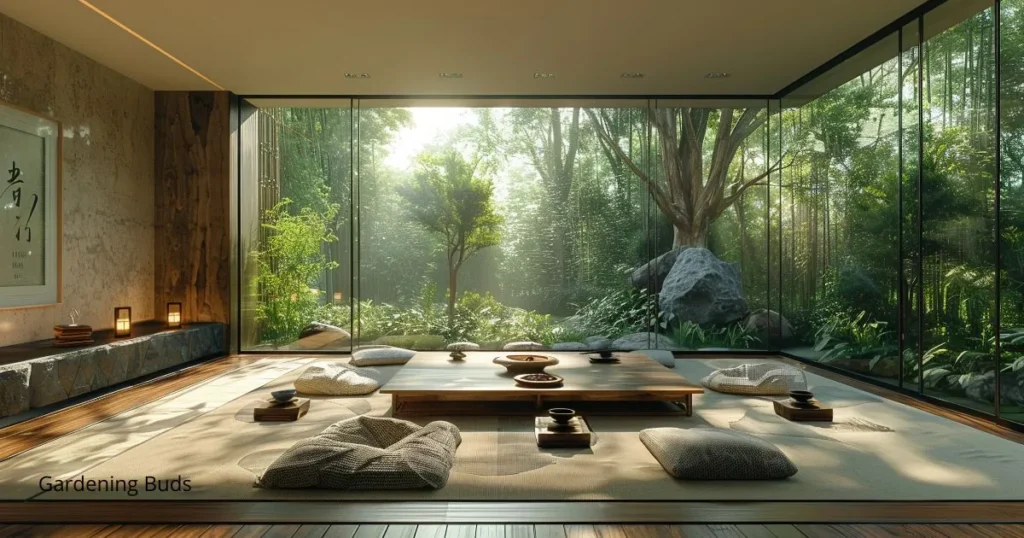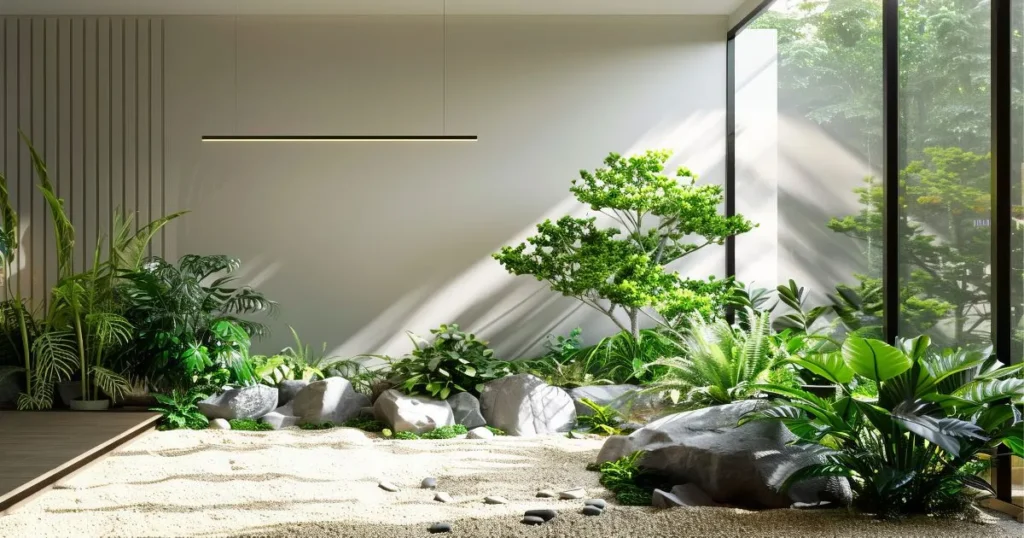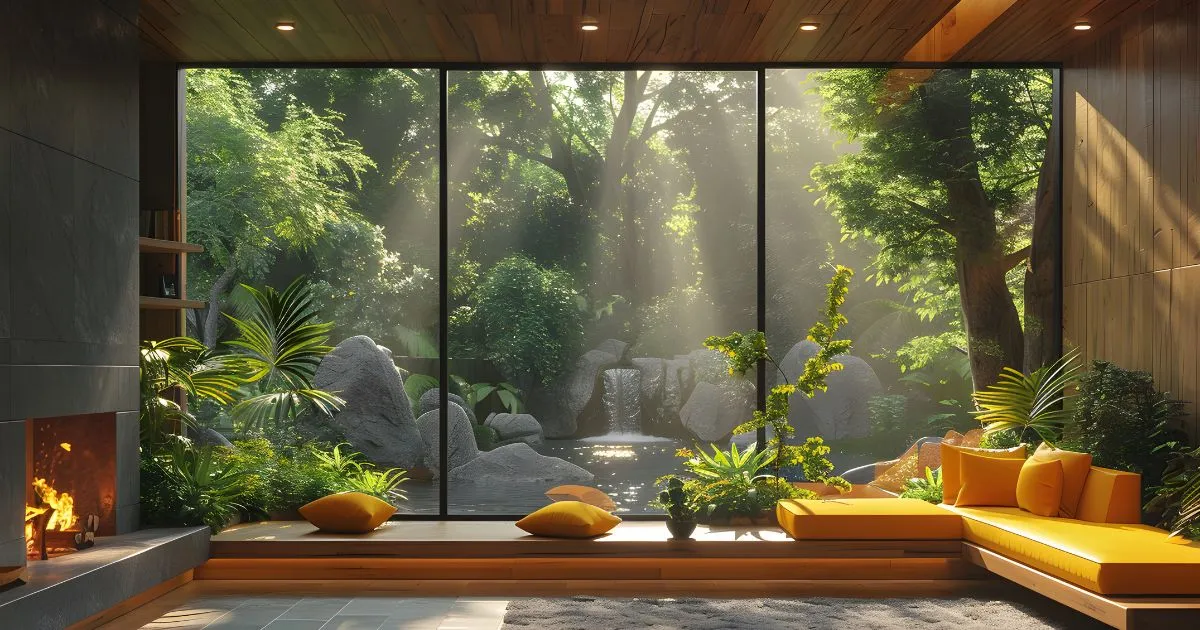Table of Contents
Introduction
In a world that is often filled with chaos and distractions, many people seek peaceful and calming spaces where they can recharge and reflect. One way to achieve this tranquility indoors is by creating an indoor zen garden. An indoor zen garden, inspired by traditional Japanese design, offers a minimalist and harmonious space that can evoke a sense of peace and mindfulness. This article will explore the history, benefits, elements, design process, and maintenance of indoor zen gardens. Additionally, we will discuss how you can incorporate this calming space into your home, transforming your living environment into a sanctuary of calm.
What is an Indoor Zen Garden?
An indoor zen garden, often referred to as a “dry landscape garden” or “Karesansui” in Japanese, is a miniature garden that incorporates a combination of rocks, sand or gravel, and plants to create a serene, tranquil environment. These gardens are intended to mimic the elements of nature—rocks symbolize mountains, sand or gravel represents water, and plants offer an element of greenery. These features come together to provide a space conducive to contemplation, meditation, and relaxation.
History and Origins of Zen Gardens
The concept of a zen garden has deep roots in Zen Buddhism and dates back to the 13th century in Japan. It evolved from Chinese garden design, which aimed to create a harmonious balance between nature and man. Zen monks designed gardens to help them focus their minds and meditate. The gardens were meant to represent elements of the natural world, but in a stylized and minimalist manner. Rocks, gravel, and sand were chosen to convey natural landscapes in abstract forms, promoting simplicity and tranquility.
As Zen gardens evolved, their design spread across Japan and eventually beyond, influencing Western culture. Today, the concept of the zen garden has been adapted in various forms and continues to be a source of inspiration for people seeking balance and mindfulness.
Elements of an Indoor Zen Garden
To understand the basic structure of an indoor zen garden, it’s essential to examine the key components that define it.
Rocks and Gravel/Sand
The most prominent features of a zen garden are the rocks and the sand or gravel that represent natural elements. Rocks are strategically placed to symbolize mountains, islands, or other natural formations, while sand or gravel represents flowing water or waves. The act of raking the sand or gravel is symbolic of the movement of water and is a meditative process in itself. Raking patterns in the sand can be designed to evoke specific feelings, such as calmness, energy, or harmony.
Plants and Moss
While the rocks and sand form the core of the zen garden, the addition of plants brings life and color to the space. Plants should be chosen carefully to complement the minimalist style of the garden. Bonsai trees, moss, and small ferns are popular choices for indoor zen gardens, as they require minimal care and maintain the serene atmosphere. The presence of green foliage provides a sense of vitality and connection to nature, which is an essential aspect of creating a calming space.
The Container or Base
The container or base of the zen garden is equally important as the materials used inside it. The base should be shallow and wide, providing ample space to arrange the rocks, sand, and plants. Traditionally, these containers were made of stone, ceramic, or wood, with wood being a popular choice for a more rustic feel. The base should be chosen to complement the overall style of the indoor space, whether it be a modern, minimalist apartment or a traditional Japanese-inspired room.

Benefits of Having an Indoor Zen Garden
Stress Reduction and Meditation
The primary benefit of an indoor zen garden is its ability to promote relaxation and reduce stress. The simple act of sitting near or in front of the garden can help calm the mind and create a meditative environment. The process of raking the sand and arranging the rocks helps center the mind, providing a therapeutic outlet for stress. The peaceful atmosphere encourages mindfulness, allowing you to focus solely on the present moment, leaving behind the worries of the day.
Incorporating meditation into your daily routine using a zen garden can have profound effects on your mental and emotional well-being. Many people use their indoor zen garden as a space for quiet contemplation or meditation, allowing them to reconnect with themselves and the natural world. Studies have shown that meditation reduces stress hormones, promotes emotional balance, and enhances overall well-being.
Improving Indoor Air Quality
An often-overlooked benefit of indoor zen gardens is their potential to improve the air quality inside your home. Plants used in zen gardens, such as bonsai trees or succulents, can purify the air by absorbing carbon dioxide and releasing oxygen. Additionally, plants help regulate humidity and remove harmful toxins from the environment. As a result, an indoor zen garden can create a healthier indoor space, adding another layer of well-being to your home.
Enhancing Aesthetics
Indoor zen gardens not only promote peace and relaxation, but they also enhance the visual appeal of any room. The minimalist design adds sophistication and elegance to your space. The carefully arranged rocks, soft colors of the gravel or sand, and the lush green plants create an inviting atmosphere that encourages both comfort and aesthetic appreciation. Whether you place your zen garden in the living room, office, or bedroom, it will serve as a focal point that enhances the overall decor of the space.
Designing Your Own Indoor Zen Garden
Creating your own indoor zen garden can be a fulfilling and rewarding process. It allows you to customize the design to fit your personal preferences while still adhering to the principles of simplicity and harmony. Here are some tips on designing your own zen garden:
Choosing the Right Space
The first step in designing your indoor zen garden is selecting the right space. This should be a quiet and peaceful area where you can fully appreciate the calming effects of the garden. It can be placed in a living room, office, or even a corner of your bedroom. Choose a space that gets adequate natural light, but avoid areas where there is direct sunlight, as this may harm the plants. Ideally, your zen garden should be located somewhere you can sit and engage with it regularly, either for meditation or simply to enjoy its tranquil beauty.
Container Selection
The container or base of your zen garden will determine the overall look and feel of the space. The container should be shallow, wide, and sturdy enough to hold the materials in place. Traditional containers are rectangular, but they can also be square, circular, or even oval, depending on the aesthetic you prefer. Wooden containers are often chosen for a more rustic, natural look, while ceramic or stone containers are suitable for a more refined or modern style.
Selecting Plants and Materials
The plants you select for your indoor zen garden should reflect the minimalist nature of the design. Bonsai trees, small ferns, and moss are all excellent choices. If you prefer a more colorful zen garden, you can opt for succulents or small flowering plants. Keep in mind that the plants should be easy to care for and suited to indoor environments. Additionally, you should consider adding decorative elements such as driftwood, pebbles, or small statues to enhance the visual appeal.
Arranging Rocks and Sand/Gravel
Arranging the rocks and sand in a balanced way is a key part of designing a zen garden. Begin by placing the largest rocks first, creating focal points or “islands” within the space. Then, add smaller rocks or pebbles around them to create depth and texture. Finally, spread the sand or gravel evenly across the container, leaving enough space for the plants. Use a rake or comb to create patterns in the sand, such as waves or concentric circles, which can enhance the meditative quality of the garden.
Maintaining Your Zen Garden
Regular Pruning and Watering
To maintain the beauty of your indoor zen garden, regular pruning and watering are essential. Trim the plants periodically to prevent overgrowth and ensure that they maintain their minimalist aesthetic. Water the plants according to their specific needs, making sure not to overwater or allow them to dry out.
Raking and Cleaning
The sand or gravel in your zen garden requires periodic raking to maintain its smooth and pristine appearance. Raking not only keeps the garden looking neat but also provides a calming activity that can be incorporated into your meditation practice. Remove any debris or fallen leaves from the garden regularly to ensure that it remains tidy and serene.

Conclusion
An indoor zen garden is more than just a decorative piece—it’s a sanctuary that brings peace, mindfulness, and tranquility into your home. Whether you’re looking to reduce stress, improve air quality, or enhance the aesthetics of your living space, a zen garden offers numerous benefits. With its minimalist design and focus on natural elements, it provides the perfect environment for relaxation and meditation. By carefully designing, arranging, and maintaining your zen garden, you can create a peaceful retreat that allows you to escape the demands of everyday life.
Frequently Asked Questions (FAQ)
What materials do I need to create an indoor zen garden?
To start, you’ll need a shallow container, rocks, gravel or sand, and suitable plants like bonsai or moss. Additionally, you may want a small rake to create patterns in the sand, as well as pruning shears for the plants.
Can I have an indoor zen garden in a small apartment?
Absolutely! Indoor zen gardens are versatile and can be adapted to fit any space, from small apartments to larger homes. Choose compact plants and a suitable container size to match your available space.
How often do I need to maintain my indoor zen garden?
Maintenance frequency depends on factors like plant type and environmental conditions. Generally, light pruning and raking every few weeks should suffice to keep your garden looking serene and tidy.
How do I create the right ambiance for my indoor zen garden?
To enhance the calming atmosphere of your indoor zen garden, consider the lighting, colors, and overall decor of the surrounding space. Soft lighting, neutral tones, and a clean, uncluttered room will help complement the serene environment of your garden.

